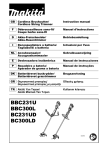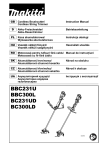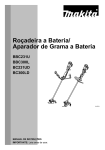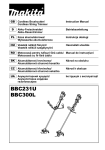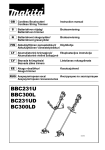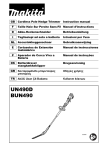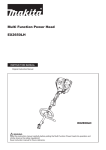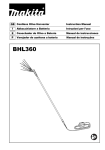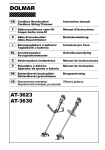Download Makita BBC300L Instruction manual
Transcript
ENGLISH (Original instructions) INSTRUCTION MANUAL Cordless Brushcutter / Cordless String Trimmer BBC231U BBC300L BC231UD BC300LD 010751 IMPORTANT: Read Before Using. 1 ENGLISH (Original instructions) SPECIFICATIONS Model BBC231U / BC231UD Type of handle Bike handle No load speed High 0 - 7,300 min-1 Low 0 - 5,300 min-1 Overall length 1,880 mm Cutting blade diameter 230 mm Net weight 7.1 kg Rated voltage D.C. 36 V Standard battery cartridge and charger Always keep the combinations of battery/charger on the right columns. BL3626 DC36RA Model BL3622A DC36WA BBC300L / BC300LD Type of handle Loop handle No load speed High 0 - 6,600 min-1 Low 0 - 4,900 min-1 Overall length 1,850 mm Cutting diameter with nylon cutting head 300 mm Net weight 5.9 kg Rated voltage D.C. 36 V Standard battery cartridge and charger Always keep the combinations of battery/charger on the right columns. BL3626 DC36RA BL3622A DC36WA • Due to our continuing program of research and development, the specifications herein are subject to change without notice. • Specifications and battery cartridge may differ from country to country. • Weight, with battery cartridge, according to EPTA-Procedure 01/2003 Noise Sound pressure level average Model LPA (dB(A)) Uncertainty K (dB(A)) Applicable standard BBC231U / BC231UD 79.7 2.5 ISO22868 BBC300L / BC300LD 79.3 2.5 EN786 • Even if the sound pressure level listed above is 80 dB(A) or less, the level under working may exceed 80 dB(A). Wear ear protection. Vibration Left hand Model 2 ah (m/s ) Right hand Uncertainty K 2 (m/s ) 2 ah (m/s ) • Applicable standard BBC231U / BC231UD 2.5 1.5 2.5 1.5 ISO22867, EN786 BBC300L / BC300LD 2.5 1.5 2.5 1.5 EN786 ENG901-1 • Uncertainty K 2 (m/s ) The declared vibration emission value has been measured in accordance with the standard test method and may be used for comparing one tool with another. The declared vibration emission value may also be used in a preliminary assessment of exposure. • • 2 WARNING: The vibration emission during actual use of the power tool can differ from the declared emission value depending on the ways in which the tool is used. Be sure to identify safety measures to protect the operator that are based on an estimation of exposure in the actual conditions of use (taking account of all parts of the operating cycle such as ENH035-4 the times when the tool is switched off and when it is running idle in addition to the trigger time). For European countries only EC Declaration of Conformity END008-4 We Makita Corporation as the responsible manufacturer declare that the following Makita machine(s): Designation of Machine: Cordless Brushcutter Model No./ Type: BBC231U,BC231UD Specifications: see "SPECIFICATIONS" table. are of series production and Conforms to the following European Directives: 2000/14/EC, 2006/42/EC And are manufactured in accordance with the following standards or standardised documents: EN/ISO11806, EN60745 The technical documentation is kept by: Makita International Europe Ltd. Technical Department, Michigan Drive, Tongwell, Milton Keynes, Bucks MK15 8JD, England Symbols The following show the symbols used for the equipment. Be sure that you understand their meaning before use. Take particular care and attention. Read instruction manual. Danger; be aware of thrown objects. The distance between the tool and bystanders must be at least 15 m. Keep bystanders away. Keep distance at least 15 m. Avoid kickback. Wear a helmet, goggles and ear protection. Wear protective gloves. The conformity assessment procedure required by Directive 2000/14/EC was in Accordance with annex V. Measured Sound Power Level: 93.6dB (A) Guaranteed Sound Power Level: 95dB (A) Wear sturdy boots with nonslip soles. Steeltoed safety boots are recommended. Do not expose to moisture. 2.10.2012 Top permissible tool speed. Cd Ni-MH Li-ion 000230 Tomoyasu Kato Director Makita Corporation 3-11-8, Sumiyoshi-cho, Anjo, Aichi, 446-8502, JAPAN Only for EU countries Do not dispose of electric equipment or battery pack together with household waste material! In observance of European Directive 2012/19/EU on waste electric and electronic equipment, 2006/66/EC on batteries and accumulators and waste batteries and accumulators and their implementation in accordance with national laws, electric equipment and battery pack that have reached the end of their life must be collected separately and returned to an environmentally compatible recycling facility. ENH040-3 For European countries only EC Declaration of Conformity We Makita Corporation as the responsible manufacturer declare that the following Makita machine(s): Designation of Machine: Cordless String Trimmer Model No./ Type: BBC300L,BC300LD Specifications: see "SPECIFICATIONS" table. are of series production and Conforms to the following European Directives: 2000/14/EC, 2006/42/EC And are manufactured in accordance with the following standards or standardised documents: EN709, EN/ISO10517, EN/ISO11680, EN/ISO11806, EN60745 3 The technical documentation is kept by: Makita International Europe Ltd. Technical Department, Michigan Drive, Tongwell, Milton Keynes, Bucks MK15 8JD, England General instructions 1. The conformity assessment procedure required by Directive 2000/14/EC was in Accordance with annex VIII. Notified Body: TÜV Rheinland LGA Products GmbH Tillystraße 2 90431 Nürnberg, Germany Identification number 0197 Measured sound power level 91.3dB(A) Guaranteed sound power level 93dB(A) The EC-Type Examination Certificate No. as a pole saw with pole saw attachment is: 4811008.12016 The EC-Type Examination per 2006/42/EC was performed by: DEKRA Testing and Certification GmbH Enderstraße 92b 01277 Dresden, Germany Identification No. 2140 2. 3. 4. 5. 6. 7. 8. Never allow people unfamiliar with these instructions, people (including children) with reduced physical, sensory or mental capabilities, or lack of experience and knowledge to use the tool. Children should be supervised to ensure that they do not play with the tool. Before starting the tool, read this instruction manual to become familiar with the handling of the tool. Do not lend the tool to a person with insufficient experience or knowledge regarding handling of brushcutters and string trimmers. When lending the tool, always attach this instruction manual. Handle the tool with the utmost care and attention. Never use the tool after consuming alcohol or drugs, or if feeling tired or ill. Never attempt to modify the tool. Follow the regulations about handling of brushcutters and string trimmers in your country. Personal protective equipment 2.10.2012 000230 Tomoyasu Kato Director Makita Corporation 3-11-8, Sumiyoshi-cho, Anjo, Aichi, 446-8502, JAPAN 013122 1. GEB068-3 2. IMPORTANT SAFETY INSTRUCTIONS 3. WARNING! Read all safety warnings and all instructions. Failure to follow the warnings and instructions may result in electric shock, fire and/or serious injury. 4. Save all warnings and instructions for future reference. Work area safety 1. Intended use 1. Wear safety helmet, protective goggles and protective gloves to protect yourself from flying debris or falling objects. Wear ear protection such as ear muffs to prevent hearing loss. Wear proper clothing and shoes for safe operation, such as a work overall and sturdy, nonslip shoes. Do not wear loose clothing or jewelry. Loose clothes, jewelry or long hair can be caught in moving parts. When touching the cutting blade, wear protective gloves. Cutting blades can cut bare hands severely. The cordless brushcutter/string trimmer is only intended for cutting grass, weeds, bushes and undergrowth. It should not be used for any other purpose such as edging or hedge cutting as this may cause injury. 2. 4 Operate the tool under good visibility and daylight conditions only. Do not operate the tool in darkness or fog. Do not operate the tool in explosive atmospheres, such as in the presence of flammable liquids, gases or dust. The tool creates sparks which may ignite the dust or fumes. 3. 4. 5. 6. During operation, never stand on an unstable or slippery surface or a steep slope. During the cold season, beware of ice and snow and always ensure secure footing. During operation, keep bystanders or animals at least 15 m away from the tool. Stop the tool as soon as someone approaches. Before operation, examine the work area for stones or other solid objects. They can be thrown or cause dangerous kickback and result in serious injury and/or property damage. WARNING: Use of this product can create dust containing chemicals which may cause respiratory or other illnesses. Some examples of these chemicals are compounds found in pesticides, insecticides, fertilizers and herbicides. Your risk from these exposures varies, depending on how often you do this type of work. To reduce your exposure to these chemicals: work in a well ventilated area, and work with approved safety equipment, such as those dust masks that are specially designed to filter out microscopic particles. Putting into operation 1. 2. 3. 4. 5. 6. 7. Electrical and battery safety 1. 2. 3. 4. 5. 6. 7. Do not expose the tool to rain or wet conditions. Water entering the tool will increase the risk of electric shock. Do not use the tool if the switch does not turn it on and off. Any tool that cannot be controlled with the switch is dangerous and must be repaired. Prevent unintentional starting. Ensure the switch is in the off-position before installing a battery pack, picking up or carrying the tool. Carrying the tool with your finger on the switch or energising the tool that have the switch on invites accidents. Recharge only with the charger specified by the manufacturer. A charger that is suitable for one type of battery pack may create a risk of fire when used with another battery pack. Use the tool only with specifically designated battery packs. Use of any other battery packs may create a risk of injury and fire. When battery pack is not in use, keep it away from other metal objects, like paper clips, coins, keys, nails, screws or other small metal objects, that can make a connection from one terminal to another. Shorting the battery terminals together may cause burns or a fire. Under abusive conditions, liquid may be ejected from the battery; avoid contact. If contact accidentally occurs, flush with water. If liquid contacts eyes, seek medical help. Liquid ejected from the battery may cause irritation or burns. Before assembling or adjusting the tool, remove the battery cartridge. Before handling the cutter blade, wear protective gloves. Before installing the battery cartridge, inspect the tool for damages, loose screws/nuts or improper assembly. Sharpen blunt cutter blade. If the cutter blade is bent or damaged, replace it. Check all control levers and switches for easy action. Clean and dry the handles. Never attempt to switch on the tool if it is damaged or not fully assembled. Otherwise serious injury may result. Remove any adjusting key or wrench before turning the tool on. A wrench or a key left attached to a rotating part of the tool may result in personal injury. Adjust the shoulder harness and hand grip to suit the operator's body size. When inserting a battery cartridge, keep the cutting attachment clear of your body and other object, including the ground. It may rotate when starting and may cause injury or damage to the tool and/or property. Operation 1. 2. 3. 4. 5. 6. 7. 8. 9. 5 In the event of an emergency, switch off the tool immediately. If you feel any unusual condition (e.g. noise, vibration) during operation, switch off the tool. Do not use the tool until the cause is recognized and solved. The cutting attachment continues to rotate for a short period after turning the tool off. Don't rush to contact the cutting attachment. During operation, use the shoulder harness. Keep the tool on your right side firmly. Do not overreach. Keep proper footing and balance at all times. Watch for hidden obstacles such as tree stumps, roots and ditches to avoid stumbling. Never work on a ladder or tree to avoid loss of control. If the tool gets heavy impact or fall, check the condition before continuing work. Check the controls and safety devices for malfunction. If there is any damage or doubt, ask our authorized service center for the inspection and repair. Do not touch the gear case. The gear case becomes hot during operation. Take a rest to prevent loss of control caused by fatigue. We recommend taking a 10 to 20-minute rest every hour. 10. 11. 12. 13. 14. 15. 16. When you leave the tool, even if it is a short time, always remove the battery cartridge. The unattended tool with the battery cartridge installed may be used by unauthorized person and cause serious accident. If grass or branches get caught between the cutting attachment and guard, always turn the tool off and remove the battery cartridge before cleaning. Otherwise the cutting attachment may rotate unintentionally and cause serious injury. If the cutting attachment hits stones or other hard objects, immediately turn the tool off. Then remove the battery cartridge and inspect the cutting attachment. Check the cutting attachment frequently during operation for cracks or damages. Before the inspection, remove the battery cartridge and wait until the cutting attachment stops completely. Replace damaged cutting attachment immediately, even if it has only superficial cracks. Never cut above waist height. Before starting the cutting operation, wait until the cutting attachment reaches a constant speed after turning the tool on. When using metal blades, swing the tool evenly in half-circle from right to left, like using a scythe. 010810 3. To avoid kickback: Apply the segment between 8 and 11 o'clock. Never apply the segment between 12 and 2 o'clock. Never apply the segment between 11 and 12 o'clock and between 2 and 5 o'clock, unless the operator is well trained and experienced and does it at his/her own risk. Never use cutting blades close to solids, such as fences, walls, tree trunks and stones. Never use cutting blades vertically, for such operations as edging and trimming hedges. Cutting attachments 1. 2. 3. Use an applicable cutting attachment for the job in hand. Nylon cutting heads (string trimmer heads) are suitable for trimming lawn grass. Metal blades are suitable for cutting weeds, high grasses, bushes, shrubs, underwood, thicket, and the like. Never use other blades including metal multipiece pivoting chains and flail blades. It may result in serious injury. Always use the cutting attachment guard properly suited for the cutting attachment used. When using metal blades, avoid "kickback" and always prepare for an accidental kickback. See the section "Kickback." 010811 Vibration 1. 2. Kickback (Blade thrust) 1. 2. Kickback (blade thrust) is a sudden reaction to a caught or bound cutting blade. Once it occurs, the tool is thrown sideway or toward the operator at great force and it may cause serious injury. Kickback occurs particularly when applying the blade segment between 12 and 2 o'clock to solids, bushes and trees with 3 cm or larger diameter. People with poor circulation who are exposed to excessive vibration may experience injury to blood vessels or the nervous system. Vibration may cause the following symptoms to occur in the fingers, hands or wrists: "Falling asleep" (numbness), tingling, pain, stabbing sensation, alteration of skin color or of the skin. If any of these symptoms occur, see a physician! To reduce the risk of "white finger disease", keep your hands warm during operation and well maintain the tool and accessories. Transport 1. 2. 3. 6 Before transporting the tool, turn it off and remove the battery cartridge. Attach the cover to the cutting blade. When transporting the tool, carry it in a horizontal position by holding the shaft. When transporting the tool in a vehicle, properly secure it to avoid turnover. Otherwise damage to the tool and other baggage may result. ENC007-7 Maintenance 1. 2. 3. 4. 5. 6. 7. 8. IMPORTANT SAFETY INSTRUCTIONS Have your tool serviced by our authorized service center, always using only genuine replacement parts. Incorrect repair and poor maintenance can shorten the life of the tool and increase the risk of accidents. Before doing any maintenance or repair work or cleaning the tool, always turn it off and remove the battery cartridge. Always wear protective gloves when handling the cutting blade. Always clean dust and dirt off the tool. Never use gasoline, benzine, thinner, alcohol or the like for the purpose. Discoloration, deformation or cracks of the plastic components may result. After each use, tighten all screws and nuts. Do not attempt any maintenance or repair not described in the instruction manual. Ask our authorized service center for such work. Always use our genuine spare parts and accessories only. Using parts or accessories supplied by a third party may result in the tool breakdown, property damage and/or serious injury. Request our authorized service center to inspect and maintain the tool at regular interval. FOR BATTERY CARTRIDGE 1. 2. 3. 4. 5. Storage 1. 2. 3. Before storing the tool, perform full cleaning and maintenance. Remove the battery cartridge. Attach the cover to the cutting blade. Store the tool in a dry and high or locked location out of reach of children. Do not prop the tool against something, such as a wall. Otherwise it may fall suddenly and cause an injury. 6. 7. 8. 9. First aid 1. 2. Always have a first-aid kit close by. Immediately replace any item taken from the first aid kit. When asking for help, give the following information: Place of the accident What happened Number of injured persons Nature of the injury Your name Before using battery cartridge, read all instructions and cautionary markings on (1) battery charger, (2) battery, and (3) product using battery. Do not disassemble battery cartridge. If operating time has become excessively shorter, stop operating immediately. It may result in a risk of overheating, possible burns and even an explosion. If electrolyte gets into your eyes, rinse them out with clear water and seek medical attention right away. It may result in loss of your eyesight. Do not short the battery cartridge: (1) Do not touch the terminals with any conductive material. (2) Avoid storing battery cartridge in a container with other metal objects such as nails, coins, etc. (3) Do not expose battery cartridge to water or rain. A battery short can cause a large current flow, overheating, possible burns and even a breakdown. Do not store the tool and battery cartridge in locations where the temperature may reach or exceed 50 C (122 F). Do not incinerate the battery cartridge even if it is severely damaged or is completely worn out. The battery cartridge can explode in a fire. Be careful not to drop or strike battery. Do not use a damaged battery. SAVE THESE INSTRUCTIONS. Tips for maintaining maximum battery life 1. SAVE THESE INSTRUCTIONS. 2. WARNING: 3. DO NOT let comfort or familiarity with product (gained from repeated use) replace strict adherence to safety rules for the subject product. MISUSE or failure to follow the safety rules stated in this instruction manual may cause serious personal injury. 4. 7 Charge the battery cartridge before completely discharged. Always stop tool operation and charge the battery cartridge when you notice less tool power. Never recharge a fully charged battery cartridge. Overcharging shortens the battery service life. Charge the battery cartridge with room temperature at 10 C - 40 C (50 F - 104 F). Let a hot battery cartridge cool down before charging it. Charge the battery cartridge once in every six months if you do not use it for a long period of time. PARTS DESCRIPTION BBC231U / BC231UD BBC300L / BC300LD 1 1 2 2 4 5 5 3 3 4 9 11 9 6 6 12 10 10 7 7 8 8 1 Battery cartridge 7 Gear case 2 Indication lamp 8 Cutting tool 3 Switch trigger 9 Shoulder harness 4 Hanger (suspension point) 10 Buckle 5 Grip 11 Barrier 6 Guard (cutting attachment guard) 12 Guard extension 013124 8 lock-off button. This can cause switch breakage. Operating a tool with a switch that does not actuate properly can lead to loss of control and serious personal injury. FUNCTIONAL DESCRIPTION • WARNING: Always be sure that the tool is switched off and battery cartridge is removed before adjusting or checking the functions on the tool. Failure to switch off and remove the battery cartridge may result in serious personal injury from accidental start-up. 2 Installing or removing battery cartridge 1 BBC231U / BC231UD 1. Red indicator 2. Slide button 3. Battery cartridge 2 1. Lock-off button 2. Switch trigger 1 011720 1 1. Lock-off button 2. Switch trigger 3 2 BBC300L / BC300LD 010752 CAUTION: • Always switch off the tool before installing or removing of the battery cartridge. • Hold the tool and the battery cartridge firmly when installing or removing battery cartridge. Failure to hold the tool and the battery cartridge firmly may cause them to slip off your hands and result in damage to the tool and battery cartridge and a personal injury. To remove the battery cartridge, slide it from the tool while sliding the button on the front of the cartridge. To install the battery cartridge, align the tongue on the battery cartridge with the groove in the housing and slip it into place. Insert it all the way until it locks in place with a little click. If you can see the red indicator on the upper side of the button, it is not locked completely. • • 011723 To prevent the switch trigger from being accidentally pulled, a lock-off button is provided. To start the tool, press in the lock-off button and pull the switch trigger. The tool speed is increased by increasing pressure on the switch trigger. Release the switch trigger to stop. Reversing Switch for Debris Removal A B 1 CAUTION: Always install the battery cartridge fully until the red indicator cannot be seen. If not, it may accidentally fall out of the tool, causing injury to you or someone around you. Do not install the battery cartridge forcibly. If the cartridge does not slide in easily, it is not being inserted correctly. BBC231U / BC231UD 011722 1 B A Power switch action • 1. Reversing switch 2. A position depressed for normal operation 3. B position depressed for weed and debris removal WARNING: Before inserting the battery cartridge in the tool, always check to see that the switch trigger actuates properly and returns to the "OFF" position when released. Do not pull the switch trigger hard without pressing in the BBC300L / BC300LD 1. Reversing switch 2. A position depressed for normal operation 3. B position depressed for weed and debris removal 011726 This tool has a reversing switch which is only provided to change the direction of rotation so that it can be used to remove weeds and debris entangled in the tool. To operated the tool normally the "A" side of the switch 9 should be depressed. To remove weeds and debris that are jammed in the rotating head the tool can be reversed by depressing the "B" side of the switch. In the reverse position the tool will only operate for a short period of time and automatically shut off. Battery/motor protection system The battery cartridge and tool are provided with protection devices that will automatically reduce or cut off power to the tool when overload situations develop that may cause damage to the tool or battery cartridge. If the tool becomes overloaded but not locked up a protector is provided to reduce the revolutions to protect the motor. In this case the two indicator lamps described in the table below do not light or blink. All other protection functions can be identified by the indicator lights described in the table below. WARNING: Always be sure that the tool is switched off and battery cartridge is removed before removing weeds or debris entangled in the tool that could not be removed when operated in the reverse mode. Failure to switch off and remove the battery cartridge may result in serious personal injury from accidental start-up. NOTICE: • Always check the direction of rotation before operation. • Use the reversing switch only after the tool comes to a complete stop. Changing the direction of rotation before the tool stops may damage it. • 1 010765 Speed change 1. Speed change switch lever 1 BBC231U / BC231UD 011721 1. Speed change switch lever 1 2 BBC300L / BC300LD 1 011724 Two speed ranges can be preselected with the speed change switch. Flipping the speed change switch lever to the "1" position will set the tool to the low speed range and the "2" position will set the tool to the high speed range. 10 1. Indication lamp Action to be taken Status - Blinking Battery power has been nearly used up. Replace the battery with fully charged one. - Lighting On Battery protector is shutting off the power battery power has been used up. Replace the battery with fully charged one. Release the switch trigger and remove the cause of the motor lock or overload. If the cutting tool is locked by entangling weeds or the like, always remove the battery cartridge before clearing it. Blinking - Overload protector is shutting off the power - the motor was locked. Lighting On - Overheat protector is shutting off the power - overheating. Rest the equipment for a while. Blinking Blinking Electric or electronic malfunction Ask your local authorized service center for repairs. 010823 Nylon cutting head (optional accessory for a product that comes with a cutter blade) Battery remaining capacity indicator (only for models with Battery BL3622A) NOTICE: • Do not attempt to bump feed the head while the tool is operating at a high RPM. Bump feeding at a high RPM may cause damage to the nylon cutting head. • The bump feed will not operate properly if the head is not rotating. Battery BL3622A is equipped with the battery remaining capacity indicator. 1 1. Indicator lamps 2. CHECK button 1 1. Most effective cutting area 2 011715 Press the CHECK button to indicate the battery remaining capacity. The indicator lamps will then light for approx. three seconds. 010770 The nylon cutting head is a dual string trimmer head provided with a bump & feed mechanism. To cause the nylon cord to feed out, the cutting head should be bumped against the ground while rotating at a low RPM. As the nylon cord is feeding out it will automatically be cut to the proper length by the cutters on the guard extension. NOTE: If the nylon cord does not feed out while bumping the head, rewind/replace the nylon cord by following the procedures described under "Maintenance." 11 Installing the handle For model BBC231U,BC231UD Indicator lamps Lighted Off E Blinking F Remaining capacity 1. Grip 2. Handle 3. Screw 1 70% to 100% 45% to 70% 3 20% to 45% 0% to 20% 2 Charge the battery. 012456 The battery may have malfunctioned. Insert the shaft of the handle into the grip as shown. Align the screw hole in the grip with the one in the shaft. Tighten the screw securely. 011713 • • • When only the lowermost indicator lamp (next to the "E") blinks, or when none of the indicator lamps light, the battery capacity has run out, so the tool does not operate. In these cases, charge the battery or replace the empty battery with a fully charged one. When two or more indicator lamps do not light even after charging is complete, the battery has reached the end of its service life. When the upper two and lower two indicator lamps light alternately, the battery may have malfunctioned. Contact your local Makita authorized service center. 2 3 4 011485 Loosen knob. Place handle between handle clamp and handle holder. Adjust the handle to an angle that provides a comfortable working position and then secure by firmly hand-tightening knob. For model BBC300L,BC300LD NOTE: • The indicated capacity may be lower than the actual level during use or immediately after using the tool. • Depending on the conditions of use and the ambient temperature, the indication may differ slightly from the actual capacity. • 1. Barrier 2. Grip 3. Spacer 4. Arrow mark 2 4 ASSEMBLY • 1. Knob 2. Handle clamp 3. Handle holder 4. Compression spring 1 3 1 WARNING: Always be sure that the tool is switched off and battery cartridge is removed before carrying out any work on the tool. Failure to switch off and remove the battery cartridge may result in serious personal injury from accidental start-up. Never start the tool unless it is completely assembled. Operation of the tool in a partially assembled state may result in serious personal injury from accidental start-up. 013123 Fit the barrier and grip onto the shaft pipe with four screws. Make sure that the grip/barrier assembly is fitted between the spacer and the arrow mark. Position the barrier on the left side of the tool. Then tighten four screws so that the grip/barrier assembly cannot move or rotate on the shaft pipe. • 12 WARNING: Do not remove or shrink the spacer. The spacer keeps a certain distance between both hands. Setting the grip/barrier assembly close to the other grip beyond the length of the spacer may cause loss of control and serious personal injury. Installing the guard 1 1. Cutter blade 2. Guard 2 1. Two bolts 2. Protector cover 3. Guard 1 2 3 010778 Fix the guard to the clamp with two bolts as shown. Tighten the right and left bolts evenly. 013140 1 1. Nylon cutting head 2. Guard 3. Guard extension 2 1 1. Guard 2. Guard extension 3 2 010768 • • 010777 WARNING: Never use the tool without the guard illustrated in place. Failure to do so can cause serious personal injury. When using a nylon cutting head, mount the guard extension. Place the guard extension onto the mounting track provided on the lower edge of the guard. And slide it into position until the guard extension clicks and locks into place. The guard extension is designed so that it will only mount onto the guard in one direction. CAUTION: While installing the guard extension be careful not to contact the sharp nylon cord cutter provided on the guard extension. Contact with the cutter could result in personal injury. NOTE: • Remove tape adhered to cutter, which cuts nylon cord, on guard extension at the first use. 1. Bolt 2. Wing 1 2 012457 Attach the protector cover onto the gear case. Slightly push the wings outward and put the bolts into the holes in the wings. NOTICE: • Do not push the wings outward too much. Otherwise it may break. 010849 To remove the guard extension, use a flat-blade screwdriver and place it into the small notch provided on the locking nub. To unlock the guard extension press down on the locking nub while sliding the lower guard extension in the direction indicated in the figure. Once the guard extension starts to slide it is unlocked and can be removed by continuing to slide it off of the guard. 13 cutter blade with the hex nut with 13 to 23 Nm of tightening torque during holding the receive washer with hex wrench. Installing the cutter blade • WARNING: The outside diameter of the cutter blade must be 230 mm. Never use any blade exceeding 230 mm in outside diameter. CAUTION: The cutter blade must be well polished, free of cracks or breakage. Polish or replace the cutter blade every three hours of operation. • Always wear gloves when handling the cutter blade. • Always attach the blade cover when the tool is not in use or is being transported. • The cutter blade-fastening nut (with spring washer) is a consumable part. If there appears any wear or deformation on the spring washer, replace the nut. Ask your local authorized service center to order it. NOTICE: • Be sure to use genuine Makita cutter blade. • 010758 Make sure that the blade is the left way up. Installing nylon cutting head CAUTION: Only use the nylon cutting head with the guard and guard extension in place. Failure to do so can cause serious personal injury. NOTICE: • Be sure to use genuine Makita nylon cutting head. Turn the tool upside down so that you can replace the nylon cutting head easily. • Turn the tool upside down so that you can replace the cutter blade easily. 6 5 4 3 2 1. Hex wrench 2. Receive washer 3. Cutter blade 4. Clamp washer 5. Cup 6. Hex nut 3 1. Threaded spindle 2. Hex wrench 3. Receive washer 1 2 010769 1 Insert the hex wrench through the hole on the protector cover and the gear case and rotate the receive washer until it is locked with the hex wrench. Mount the nylon cutting head onto the threaded spindle directly and tighten it by turning it counterclockwise. Remove the hex wrench. To remove the nylon cutting head, turn the nylon cutting head clockwise while holding the receive washer with the hex wrench. 010756 To dismount the cutter blade, insert the hex wrench through the hole on the protector cover and gear case. Rotate the receive washer until it is locked with the hex wrench. Loosen the hex nut (left-hand thread) with the socket wrench and remove the nut, cup, clamp washer and hex wrench. 1. Hex wrench • 1 010757 Mount the cutter blade onto the shaft so that the guide of the receive washer fits in the arbor hole in the cutter blade. Install the clamp washer, cup, and secure the 14 CAUTION: If during operation the nylon cutting head accidentally impacts a rock or hard object the trimmer should be stopped and inspected for any damage. If the nylon cutting head is damaged it should be replaced immediately. Use of a damaged nylon cutting head could result in serous personal injury. Detachment OPERATION 1. Buckle Correct handling of tool (BBC231U,BC231UD) Correct posture • WARNING: Always position the tool on your right-hand side so that the shaft of the left handle is always in front of your body. Correct positioning of the tool allows for maximum control and will reduce the risk of serious personal injury caused by kickback. 1 010759 The buckle is provided with a means of quick release which can be accomplished by simply squeezing the sides and the buckle. WARNING: Be extremely careful to maintain control of the tool at this time. Do not allow the tool to be deflected toward you or anyone in the work vicinity. Failure to do so could result in serious injury. Adjustment of the hanger position and shoulder harness When replacing an accessory with another, the weight balance of the tool may change. In such case, adjust the hanger position and shoulder harness length as follows. To change the hanger position, loosen the fixing screw on the hanger with the supplied wrench and then move the hanger and the cushion. The cushion can be moved easily by twisting it. • 010753 As shown in the figure fit the shoulder harness and hang the tool firmly on your right side so that the shaft of the left handle is always ahead of you. Attachment of shoulder harness 1. Hanger 1 1. Lever 012478 Adjust the hanger position and shoulder harness length so that: the hanger positions 750mm or higher from the ground, the cutting tool positions 100mm to 300mm high from the ground and the unguarded part of cutting tool is horizontally 750mm or farther away from the hanger. After adjusting the hanger position, tighten the screw with the wrench securely. 1 010760 Wear the shoulder harness on your back and buckle it up until a click is heard. Make sure that it cannot be taken off with pulling it off. Hang the tool as shown. 15 Detachment Correct handling of tool (BBC300L,BC300LD) Correct posture • WARNING: Always position the tool on your right-hand side so that the barrier is always in front of your body. Correct positioning of the tool allows for maximum control and will reduce the risk of serious personal injury caused by kickback. 010817 The buckle is provided with a means of quick release which can be accomplished by simply squeezing the sides and the buckle. WARNING: Be extremely careful to maintain control of the tool at all times. Do not allow the tool to be deflected toward you or anyone in the work vicinity. Failure to keep control of the tool could result in serious injury to the bystander and the operator. Adjustment of the hanger position and shoulder harness When replacing an accessory with another, the weight balance of the tool may change. In such case, adjust the hanger position and shoulder harness length as follows. To change the hanger position, loosen the fixing screw on the hanger with the supplied wrench and then move the hanger. • 010767 As shown in the figure, put the shoulder harness on your left shoulder by putting your head and right arm through it and keep the tool on your right side while always keeping the barrier in front of your body. Attachment of shoulder harness 1. Hanger 1 012479 Adjust the hanger position and shoulder harness length so that: the hanger positions 750mm or higher from the ground, the cutting tool positions up to 300mm high from the ground and the unguarded part of cutting tool is horizontally 750mm or farther away from the hanger. After adjusting the hanger position, tighten the screw with the wrench securely. 010816 After putting the shoulder harness on it can be attached to the tool by connecting the buckles provided on both the tool hook and the harness. Be sure that the buckles click and lock completely in place. 16 cord. MAINTENANCE 1. Spool 2. For left hand rotation 80mm WARNING: • Always be sure that the tool is switched off and battery cartridge is removed before attempting to perform inspection or maintenance on the tool. Failure to switch off and remove the battery cartridge may result in serious personal injury from accidental start-up. NOTICE: Never use gasoline, benzine, thinner, alcohol or the like. Discoloration, deformation or cracks may result. 1 2 010992 Hook the middle of the new nylon cord to the notch located at the center of the spool between the 2 channels provided for the nylon cord. One side of the cord should be about 80mm longer than the other side. Wind both ends firmly around the spool in the direction marked on the head for left hand direction indicated by LH. Supply of grease to gear case 1. Grease hole 2. Gear case 1. Notches 1 100mm 2 010812 1 Supply grease (Shell Alvania 2 or equivalent) to the gear case through the grease hole every 30 hours. (Genuine Makita grease may be purchased from your Makita dealer.) 010993 Wind all but about 100 mm of the cords, leaving the ends temporarily hooked through a notch on the side of the spool. Replacing the nylon cord • • WARNING: Always be sure that the tool is switched off and battery cartridge is removed before attempting to perform inspection or maintenance on the tool. Failure to switch off and remove the battery cartridge may result in serious personal injury from accidental start-up. Make sure that the cover of the nylon cutting head is secured to the housing properly as described below. Failure to properly secure the cover may cause the nylon cutting head to fly apart resulting in serious personal injury. 1 1 010994 Mount the spool in the housing so that the grooves and protrusions on the spool match up with those in the housing. Keep the side with letters on the spool visible on the top. Now, unhook the ends of the cord from their temporary position and feed the cords through the eyelets to come out of the housing. 1. Cover 2. Latches 3. Press 2 3 1. Eyelets 3 010772 Press inward on the housing latches and lift upward to remove the cover. Discard any of the remaining nylon 17 1 2 1. Cover 2. Protrusion (Not shown) 3. Slot of the eyelet 3 010776 Align the protrusion on the underside of the cover with the slots of the eyelets. Then push cover firmly onto the housing to secure it. Make sure the latches fully spread in the cover. To maintain product SAFETY and RELIABILITY, repairs, any other maintenance or adjustment should be performed by Makita Authorized Service Centers, always using Makita replacement parts. 18 TROUBLE SHOOTING Before asking for repairs, conduct your own inspection first. If you find a problem that is not explained in the manual, do not attempt to dismantle the tool. Instead, ask Makita Authorized Service Centers, always using Makita replacement parts for repairs. Malfunction status Motor does not run. Motor stops running after a little use. Action Cause Battery cartridge is not installed. Install the battery cartridge. Battery problem (under voltage) Recharge the battery. If recharging is not effective, replace battery. The drive system does not work correctly. Ask your local authorized service center for repair. Rotation is in reverse. Change the direction of rotation with the reversing switch. Battery's charge level is low. Recharge the battery. If recharging is not effective, replace battery. Overheating. Battery is installed improperly. It does not reach maximum RPM. Cutting tool does not rotate: stop the machine immediately! Abnormal vibration: stop the machine immediately! Cutting tool and motor cannot stop: Remove the battery immediately! Stop using of tool to allow it to cool down. Install the battery cartridge as described in this manual. Battery power is dropping. Recharge the battery. If recharging is not effective, replace battery. The drive system does not work correctly. Ask your local authorized service center for repair. Foreign object such as a branch is jammed between the guard and the nylon cutting head or cutter blade. Remove the foreign object. Cutter blade fastening nut is loose. Tighten the nut properly as described in this manual. The cutter blade is bended. Replace the cutter blade. The drive system does not work correctly. Ask your local authorized service center for repair. One of nylon cord has been broken and the head got unbalanced. Bump the nylon cutting head against the ground while it is rotating to cause the cord to feed. The cutter blade is bended, cracked or worn. Cutter blade fastening nut is loose. Replace the cutter blade. Cutter blade is fastened improperly. Tighten the nut properly as described in this manual. The drive system does not work correctly. Ask your local authorized service center for repair. Electric or electronic malfunction. Remove the battery and ask your local authorized service center for repair. 010824 19 OPTIONAL ACCESSORIES CAUTION: These accessories or attachments are recommended for use with your Makita tool specified in this manual. The use of any other accessories or attachments might present a risk of injury to persons. Only use accessory or attachment for its stated purpose. If you need any assistance for more details regarding these accessories, ask your local Makita Service Center. • Cutter blade • Nylon cutting head • Pole hedge trimmer attachment (for model BBC300L,BC300LD) • Pole saw attachment (for model BBC300L,BC300LD) • Cultivator attachment (for model BBC300L,BC300LD) • Makita genuine battery and charger • NOTE: • Some items in the list may be included in the tool package as standard accessories. They may differ from country to country. 20 21 22 23 Makita Corporation Anjo, Aichi, Japan 884944H226 24 www.makita.com
























